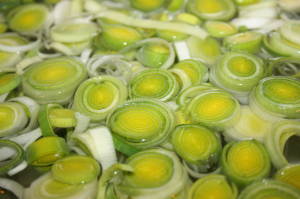Leeks are a winter vegetable that go well boiled, steamed or in soups. They are a member of the onion family but are much easier to grow than the standard bulb onion. They produce a long, wide green stem instead of a bulb. The flavor of leek is quite mild and particularly popular in European cooking. The best part of the leek is the pale white stem – the upper green bits tend to be quite chewy.
Planting Leeks
Leeks enjoy open ground the best. They can also be planted in containers or raised beds if you choose. It’s recommended to sow leeks in seed beds and then transplant them elsewhere. The seed bed technique is useful because leeks take a long time to grow, therefore hogging valuable earth that could be used for a fast-growing vegetable.
Prepare the soil a few months in advance by digging in organic matter. Leek enjoys soil that is moist but not too wet. Adding sand could be useful if the soil is naturally wet. A moderate sprinkling of general fertilizer or blood and bone is recommended.
When it comes time to sow, place them 1cm deep.
Growing Leeks
Once leeks grow to around 6 inches (15cm) tall they will need to be transplanted – this usually takes 4 to 6 weeks. How far apart to plant on transplantation varies depending on the type of leek, but a good rough guide is 6 inches (15cm) apart with rows 12 inches (30cm) apart. Plant about 3 inches (7.5cm) deep.
Care needs to be taken to blanch the stems as the leeks grow. This is most easily achieved by ‘earthing up’, or mounding earth around the stems of the leek so that it is covered by earth and protected from the sun. Try and prevent the soil from getting in between the leaves when doing this.
Leeks need water during dry periods. They need regular weeding as they are prone to being taken over like other members of the onion family. They grow quickly when fed a nitrogen based fertilizer.
Harvesting Leeks
Leeks usually take about 4-5 months from seeding to mature. You can harvest them whenever the stems are thick enough for your liking. As the stem is the best part, you need to dig carefully when pulling out leeks. Use a fork and lift them gently out of the ground once enough plant is exposed.
As leeks are quite hardy, they can stay in the ground for many months after they are mature, except for in tropical climates.
During the harvesting you may notice small plants growing off of the main stems. You can lift these off gently and put them back in the soil if you wish to grow another round of leeks.
Problems With Leeks
Snails will probably be the biggest pest threat to your leeks. You can combat snails by using snail pellets. If looking for an organic solution, you can make home-made snail traps. Thankfully, onion maggots do not attack leeks. There may be other pests local to your region, such as leek moth in the UK and thrips in Australia.
Leek leaves can rot in particularly humid climates, sometimes called ‘slimy rot’ or ‘leek rust’. Be careful not to overcrowd your leeks. This rot usually doesn’t spoil the plant. Dispose of any badly affected leaves.
White rot is perhaps the worst thing that can happen to leeks. It is a cotton-wool like fungus that is extremely hard to get rid of. If found, you should dispose of all affected leeks and as much of the soil around it as possible. If you have white rot, don’t grow any members of the onion family in that patch of soil for 10 years.


